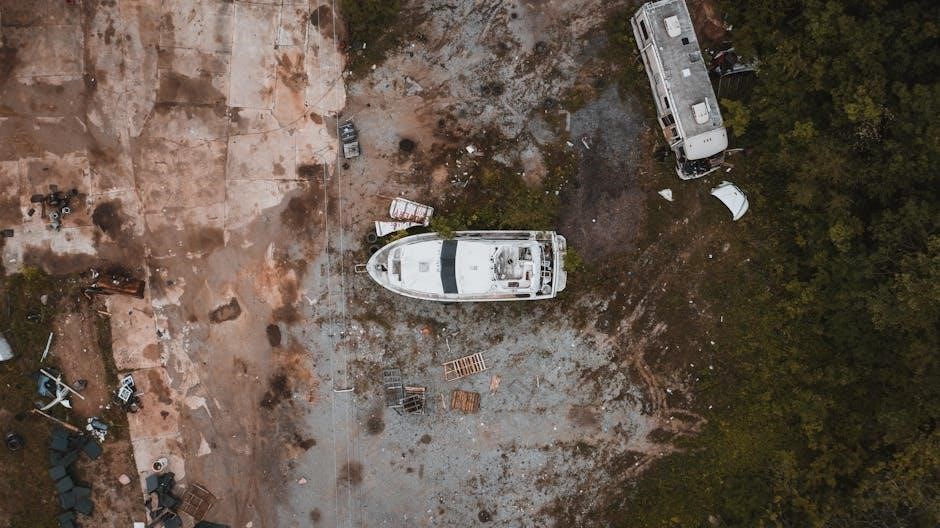Understanding Trailer Boat Guides
What are Trailer Boat Guides?
Trailer boat guides are essential accessories that assist in aligning a boat onto its trailer during loading․ These guides ensure the boat is correctly positioned, preventing damage and simplifying the retrieval process․
Why are Boat Trailer Guides Important?
Boat trailer guides protect the boat’s hull, preserving its aesthetics by preventing scrapes and impacts․ They also provide invaluable assistance in challenging conditions, making solo loading and unloading much easier․
What are Trailer Boat Guides?
Trailer boat guides are invaluable accessories designed to simplify the often-challenging task of loading a boat onto its trailer․ These guides act as visual and physical cues, helping to center the boat correctly, especially in windy conditions, strong currents, or at difficult launch ramps․ They prevent the boat from wandering during loading, ensuring it aligns properly with the trailer bunks or rollers․ By guiding the boat smoothly, they minimize the risk of damage to the hull, saving boat owners from costly repairs and preserving the vessel’s pristine condition․ Available in various styles, including rollers, bunks, and posts, boat trailer guides cater to different boat types and trailer configurations, providing a customized solution for safe and efficient boat retrieval․ They essentially transform a potentially stressful experience into a manageable one, making boat ownership more enjoyable․
Why are Boat Trailer Guides Important?
Boat trailer guides are crucially important for several reasons, primarily revolving around safety, convenience, and the protection of your valuable watercraft․ They significantly simplify the boat loading process, especially when faced with challenging conditions such as strong winds or currents, which can make centering the boat on the trailer extremely difficult․ Without guides, the boat’s hull is more susceptible to scratches, dents, and other damage during loading, potentially leading to costly repairs․ These guides act as a buffer, preventing direct contact between the boat and the trailer frame․ Furthermore, they provide a clear visual reference, making it easier to align the boat correctly, even for solo boaters․ Boat trailer guides also enhance safety by reducing the risk of accidents during loading, ensuring a secure and stable transportation setup․ Ultimately, they offer peace of mind, protecting your investment and streamlining your boating experience․

Types of Boat Trailer Guides
Roller guides utilize rotating rollers to ease the boat onto the trailer, reducing friction․ These are particularly useful for heavier boats, facilitating smoother launching and retrieval․
Roller Guides
Roller guides are a popular choice for boat trailers, known for their ability to ease the loading and unloading process, especially with heavier boats․ These guides feature multiple rollers mounted on a vertical post, strategically placed to align the boat as it’s driven or floated onto the trailer․ The rollers minimize friction, allowing the boat to glide smoothly into position, reducing the risk of hull damage․
They are particularly advantageous in situations with strong currents or windy conditions, where precise alignment can be challenging․ Roller guides are available in various configurations and materials, offering adjustability to accommodate different boat sizes and hull shapes․ Installation typically involves bolting the guide posts to the trailer frame, ensuring proper positioning for optimal performance․ Regular maintenance, such as cleaning and lubricating the rollers, is essential to ensure smooth operation and longevity, making them a reliable solution for effortless boat loading․
Bunk Guides
Bunk guides are another common type of boat trailer guide, characterized by carpeted wooden or composite bunks mounted on vertical posts․ These bunks provide a cushioned surface that supports the boat’s hull as it’s loaded onto the trailer․ Bunk guides are designed to cradle the boat, distributing its weight evenly and preventing direct contact with the trailer frame․
They are particularly well-suited for boats with flatter hulls, offering excellent support and stability during transport․ Bunk guides typically require drilling holes in the trailer frame to secure the mounting brackets․ Proper alignment is crucial to ensure the bunks make full contact with the hull, preventing any stress points․ Regular inspection of the carpeted bunks is necessary to identify and address any wear or damage, ensuring continued protection for the boat’s hull․ Bunk guides offer a reliable and cost-effective solution for many boat owners, providing secure and stable support during trailering․
Post Guides
Post guides, also known as side guides or guide-ons, are a simple and effective type of boat trailer guide, typically consisting of vertical posts extending upwards from the trailer frame․ These posts are often made of galvanized steel or PVC and may be padded or covered with carpet to protect the boat’s hull․ Post guides serve as visual cues, helping the boat operator center the boat on the trailer, particularly in windy conditions or strong currents․
They are especially useful for smaller boats and personal watercraft, providing clear reference points during loading and unloading․ Post guides are relatively easy to install, usually attaching to the trailer frame with U-bolts or clamps․ They offer a cost-effective solution for improving boat loading accuracy and preventing misalignment․ While they may not provide the same level of hull support as bunk guides, post guides significantly enhance visibility and control during the boat retrieval process, making them a popular choice for many boaters․

Choosing the Right Boat Trailer Guide
Selecting the right guide depends on your boat and trailer․ Consider boat size, hull type, and trailer design․ Different guides suit different setups, ensuring optimal performance and protection․
Matching Guides to Boat and Trailer Type
Selecting the right boat trailer guide involves carefully assessing your boat’s specific characteristics and your trailer’s design․ Consider the boat’s size, weight, and hull type․ Heavier boats often benefit from bunk-style guides for increased support․ Lighter boats may work well with roller guides, which ease launching and retrieval․
Match the guide style to the trailer’s frame․ Some guides require specific mounting points or hardware․ Ensure compatibility to avoid installation issues․ Pontoon boats, for example, need specialized trailers and guides for proper support․
Consider the trailer’s width and length in relation to the boat․ Adjustable guides offer flexibility, particularly if you plan to upgrade your boat in the future․ Investing time in selecting the correct guide system ensures easier, safer, and more secure boat loading and transport․
Considering Water Conditions
Water conditions significantly impact boat loading, so choose trailer guides accordingly․ In areas with strong currents or frequent wind, post-style guides are invaluable․ They offer a clear visual reference, helping you align the boat accurately despite external forces․ Roller guides may prove less effective in these scenarios, as the boat can easily drift off course before making contact․
For shallow ramps or areas with tidal fluctuations, consider the adjustability of your chosen guides․ Being able to modify the height ensures effective guidance, irrespective of water depth․ Bunk guides can be advantageous in shallow water, providing support even when the trailer isn’t fully submerged․
Ultimately, assess the typical launch sites you frequent and select guides that offer the greatest ease and safety, considering the prevailing water conditions․

Installation Tips for Boat Trailer Guides
Proper placement on the trailer frame is crucial for easy boat loading and unloading․ Position guides to allow smooth boat alignment, avoiding placement that hinders the process․
Proper Placement on Trailer Frame
When installing boat trailer guides, proper placement on the trailer frame is paramount for effortless boat loading and unloading․ Guides should facilitate easy boat alignment, preventing contact with the trailer frame․ Consider the boat’s hull shape and size to determine the optimal guide position, ensuring adequate clearance․ Ensure the guides do not interfere with other trailer components such as lights or fenders․
Accurate measurements are crucial․ Measure the width of your boat at the point where the guides will make contact․ Transfer these measurements to the trailer frame, marking the ideal guide locations․ Double-check alignment before securing any hardware․ Remember, the goal is to create a clear path for the boat to easily glide onto the trailer, minimizing friction and potential damage․ Securely attach the guides to the frame, ensuring stability and preventing movement during loading and transport․ Following these guidelines will significantly improve your boat loading experience․
Following Manufacturer Instructions
Adhering to the manufacturer’s instructions is critical when installing boat trailer guides․ These instructions provide specific guidance tailored to the particular guide model, ensuring proper installation and optimal performance․ Ignoring these instructions can lead to incorrect installation, potentially compromising the guide’s effectiveness and even causing damage to the boat or trailer․
Manufacturer instructions often detail the correct hardware to use, the proper torque specifications for fasteners, and any specific considerations for different trailer types․ They may also include diagrams or illustrations to aid in the installation process․ Before beginning the installation, carefully read through the entire set of instructions to familiarize yourself with the steps involved․ If any part of the instructions is unclear, contact the manufacturer for clarification․ Deviating from the manufacturer’s instructions could void any warranty associated with the guides․ By following the manufacturer’s guidelines, you ensure a safe and effective installation․

Boat Towing Safety Tips
Safe loading and unloading are essential․ Practice aligning your boat using guide poles in good conditions․ This will ensure safer, easier launches, and retrievals, minimizing risks at the ramp․
Safe Loading and Unloading Techniques
Safe loading and unloading techniques are crucial when trailering a boat․ Always take extra precautions at the ramp․ Before starting, be aware of the wind, current, and tide conditions to ensure a smooth process․ Practice aligning your boat with the trailer guides in calm conditions to master the process․
When backing the trailer into the water, avoid submerging it too deeply; aim for halfway․ This allows the boat to filter through the guides correctly․ Use the boat trailer guides to center your boat, letting you float or drive it right onto the trailer․
Secure the boat to the trailer with properly lashed straps and safety chains․ Ensure the boat is firmly pressed down onto the trailer․ After loading, double-check all connections and lights before driving․ Following these steps will make loading and unloading a safer process․
Driving with a Trailer
Driving with a trailer requires adjustments to your driving habits․ Always allow for increased following distances and braking times due to the added weight; Avoid sudden starts and stops to prevent swaying․ Practice turning and backing up with the trailer in an open area before hitting the road․ Swing wide around turns to avoid clipping curbs or obstacles․
Regularly check your mirrors to monitor the trailer’s position․ Be aware of changes in wind direction, which can affect handling․ Ensure that the trailer lights are functioning correctly for visibility and safety․ When driving, maintain a steady speed and avoid abrupt maneuvers․
Remember to familiarize yourself with local towing regulations and speed limits․ Proper weight distribution is key to safe towing, so ensure the boat is properly secured and balanced on the trailer․ By following these tips, you can ensure a safer and more comfortable driving experience with your boat trailer․
